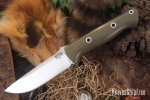- Joined
- Dec 7, 2019
- Messages
- 3,596
So around these parts, we talk a lot about how blade length and blade thickness affect function and performance. A longer length for example generally diverges into two possible routes: heavy chopper territory or sleek machete territory. Of course, some knives could competently cover those two fronts. For blade thickness, I understand this as a tradeoff between durability (er, batonability?) or ease of slicing. Thicker blades tend to be more durable but also lose out on slicing ability somewhat.
For this thread, let's define blade width as the distance between the spine and cutting edge. Does width have any noticeable effect on knife function and performance?
For this thread, let's define blade width as the distance between the spine and cutting edge. Does width have any noticeable effect on knife function and performance?








